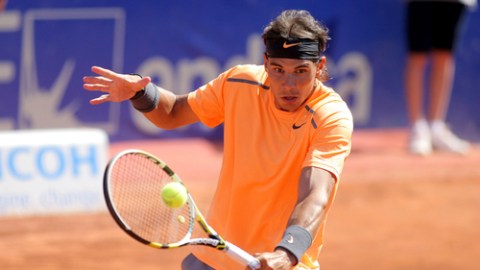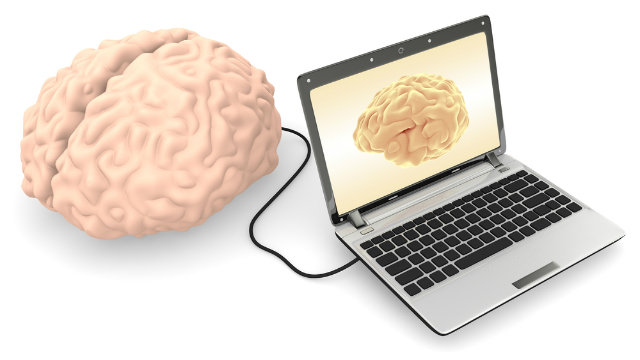String Theory: The Physics of Tennis at Its Best

This is going to be a big weekend of tennis for me, on my couch. That’s right, I don’t expect to even pick up a racket. There’s no time for that, considering that I’ve cleared off my DVR and set it to record hours upon hours of the Tennis Channel and ESPN2, starting at 5am every morning. That means I have a lot of catching up to do on what I consider to be the best tennis of the year, which is played on the red clay courts of Roland Garros.
Hooray for clay!
Great athletes have a way of making the game look easy. On the other hand, the clay courts of Roland Garros have a way of making certain athletes appear very mortal. It happens every year, and that is why this particular Grand Slam event is perhaps the best test for the finest (and smartest) athletes in the world. It all comes down to physics.
What’s the Big Idea?
As Jonah Lehrer points out in “The Physics of Grass, Clay, and Cement,’’ his excellent essay on the physics of tennis published last year:
During a typical rally, the ball will spend more than 99.5 percent of its time traveling between players, sailing through the air and ricocheting off the ground. It is in contact with the racket for the remaining fraction of a percent. The players control that fraction. Physics controls everything else.
Imagine if tennis, like most other sports, had only one type of playing surface. It would be significantly easier for a single player to dominate the sport through pure “athleticism.” That would make a tennis match the survival of the strongest, as opposed to a competition of the truly fittest — in terms of offering the full test of the set of skills that challenge the body and mind in equal measure.
Thankfully that is not the case. The International Tennis Federation recognizes 160 different types of surfaces. “That’s a lot of frictional coefficients for Novak and Rafa to keep track of,” The New York Times points out, “if they want to understand the physics of the bouncing balls they’re trying to hit.”
The coefficient of friction, “a measurement of the abrasive force between the ground and the tennis ball,” writes Lehrer, is the most important factor at play in tennis. The clumps of crushed brick that make up clay court surfaces, for instance, act as a “speed bump,” resulting in the slow, high bounces that make it harder to hit winners. Professor Rod Cross, associate professor in the school of physics at the University of Sydney, uses the word “stick” to describe the friction that slows down a ball on clay.
In marked contrast to clay surfaces is the frictional coefficient of the grass courts of Wimbledon and the Har-Tru courts of the U.S. and Australian Open events that partisans of clay say can exaggerate a player’s skill level. In other words, fast courts can reward brute force while the physics of clay requires a more refined skill set, and great finesse, not to mention the physical and mental endurance required for extended volleys.
Does that mean clay court tennis is the only “real” tennis? Certainly not. It would be a regrettable thing for the sport if tennis courts were to become homogenized. After all, it is the mark of a truly elite player who can adapt to different surfaces, alter his or her playing style accordingly, and win at the highest level. That is why it happens so rarely.
For over a decade, Bjorn Borg owned Wimbledon and the French Open but wasn’t able to translate that dominance over to the hard court. On the other hand, Pete Sampras won 14 grand slam titles but never the French Open. Indeed, the history of tennis in the Open Era has been the triumph of the specialist. Andre Agassi was a rare exception.
That is no longer the case today. There are two active players, Roger Federer and Rafael Nadal, who have won the Career Grand Slam, which means winning the four Major tennis tournaments that are played on three different surfaces — clay, grass and hard court. A third player, Novak Djokovic, is hoping to join this elite company with a win at the French Open later this month. It is no accident that these players are ranked 1, 2 and 3 in the world, considering the remarkable fact that at least one of the three has appeared in a Grand Slam Final dating back to January, 2005. Based on this trio’s uncommon feats, many consider today to be the golden age of men’s singles tennis.
What’s the Significance?
Like Babe Ruth, who hit 59 home runs for The New York Yankees in 1921 when the next highest total was 24, the gap between Djokovic, Nadal, Federer, and everyone else, is enormous (sorry, Andy Murray).
So what accounts for this? I don’t know, and that is what makes the current competition so thrilling to watch.
After all, as we’ve noted, you need to be a “physicist” as well as a bona fide athlete to win a grand slam. Alright, not to push this point too far, as Lehrer notes, “Roger Federer probably isn’t thinking about the angular momentum of his cross-court shot when approaching the net, just as Andy Roddick isn’t contemplating the “kinetic chain principle” before unleashing his serve.” The game is simply played too fast for anyone to think about physics. It is one thing to return a 125 mph serve. It is quite another thing to be computing data while you’re at it.
Fair enough. And yet, there is a lot to be said about playing intelligently, even though it is difficult to define what that means. According to Douglas Hofmann, a materials scientist at the Jet Propulsion Laboratory and Caltech who Lehrer quotes in his essay, top ranked players like Djokovic, Nadal and Federer are all “intuitive physicists” who know how the ball will bounce “even if they can’t explain why.”
In fact, few can explain why players like Federer are able to perform acts that seem like magic on the court, although poets have certainly tried. After witnessing a so-called “Federer Moment,” David Foster Wallace described his reaction to a play at the 2005 U.S. Open in his great New York Times essay, “Federer as Religious Experience”:
…given Agassi’s position and world-class quickness, Federer had to send that ball down a two-inch pipe of space in order to pass him, which he did, moving backwards, with no setup time and none of his weight behind the shot. It was impossible. It was like something out of “The Matrix.” I don’t know what-all sounds were involved, but my spouse says she hurried in and there was popcorn all over the couch and I was down on one knee and my eyeballs looked like novelty-shop eyeballs.
So what exactly does it mean to be an “intuitive physicist” and how does one become one? How does one learn to gauge the velocity, the angular and linear momentum of the ball, select a shot, and deliver a winner better than the world’s best competition? Can it be learned?
If you know the answer to that question, you will put Ivan Lendl and other tennis greats out of a coaching job.
And yet, as we’ve noted, a rudimentary survey of the physical forces at play on the court can go a long way to serve the coach and player and fan, in different ways, of course. Jonah Lehrer suggests that a crash course in physics would certainly help pro tour players gain an advantage in a sport in which the slightest edge can make the difference in a match.
For us mortals, physics can help us be better fans and deepen our appreciation of the game, and understand the link between the mental and the physical. After all, one need only look to a few notable ‘failed physicists’ from the early rounds at Roland Garros to see how valuable the ‘intuitive’ skill of physics is on the court.
Consider the collapse of Serena Williams, who exited in the first round despite a 5-1 lead in the second set tie-breaker. The best clay court players utilize a defensive strategy. Control the ball and let the other guy make a mistake. Williams is a great finisher, but she was overly aggressive, overhitting as she tried to put Frenchwoman Virginie Razzano away.
Or consider the clay court misery of former #1 ranked Andy Roddick. After his first-round exit at Roland Garros, a dumbfounded Roddick told the press, “You can’t fake it out here…I move horrendously out here. My first step is so bad on this stuff. I feel like I’m always shuffling or hopping or not stopping or something.”
Roddick, of course, will have his chance to rebound on the fast surfaces of Wimbeldon. In the meantime, all the attention is on the Big Three, Djokovic, Nadal and Federer, those intuitive physicists who can adapt to any surface and play at the highest level of their sport.





